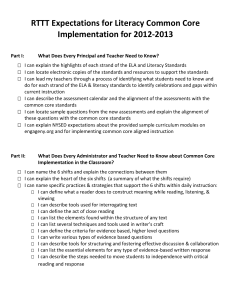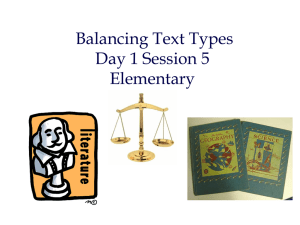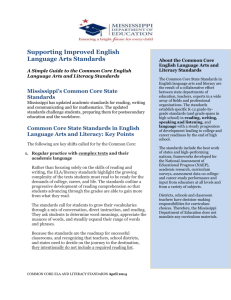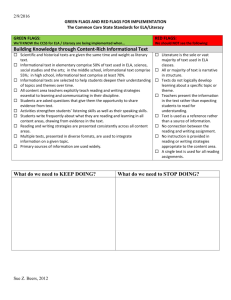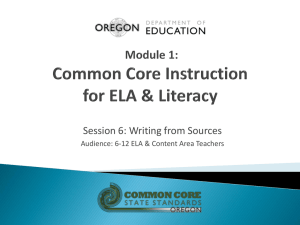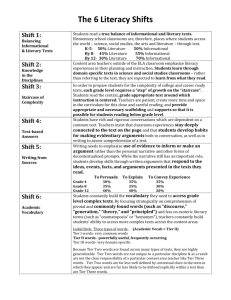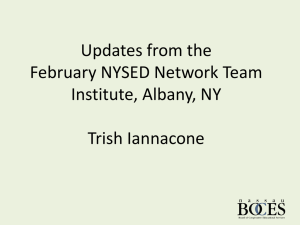Leading The Change To Common Core State Standards
advertisement
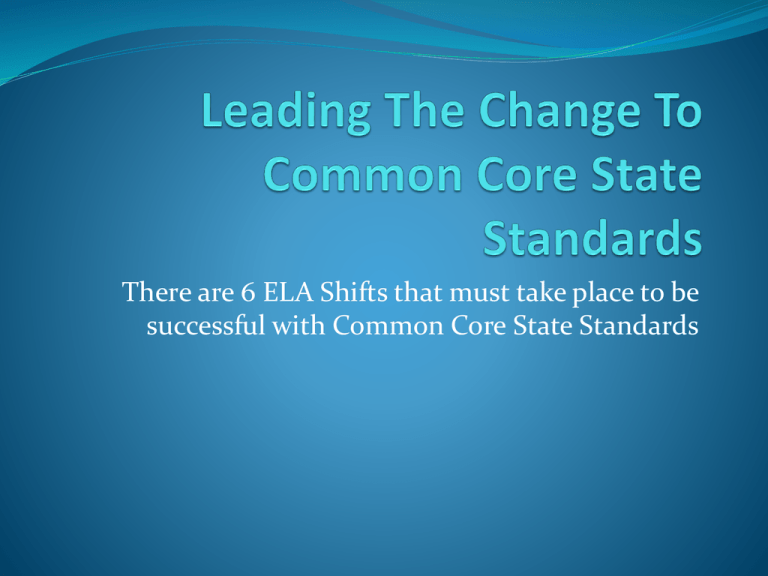
There are 6 ELA Shifts that must take place to be successful with Common Core State Standards Staff Development This workshop will give you the essential tools needed to plan effective staff development for the 6 ELA Shifts. When planning your staff development for the 20132014 school year, you need to make Common Core training your FIRST PRIORITY. Put all of your Common Core training on your staff development calendar first and then plug in all the other things that need to be scheduled. Staff Development Think about all of the time you possibly have for Common Core training. Think about using planning periods, grade level meetings, and faculty meetings for training. At the end of this training, you will have some tools in your hands that will help you plan your staff development. What should ELA and Literacy look like in a Common Core Classroom? Simple Version Students are reading A LOT. Students are engaging with questions about what they are reading about in small groups. Students are writing about what they are reading about. What Do We Need to Examine? What are students doing in the classroom? What are teachers doing in the classroom? What teachers and students are doing in the classroom should look very different with the Common Core State Standards. What is your Vision? Think about what you want your classrooms to look like. Work Forward not Backward. Don’t try to match up what you are already doing with the new standards. If you do this, you are looking back and trying to make it match what you are already doing. Desired State The desired state should be all kids college and career ready. REALLY READY! Think about the desired state and work FORWARD to the desired goal. Major Shift We are asking teachers to engage students in inquiry based learning and they don’t know how to do this. A total shift must happen before you can be successful. The whole culture of the school must change. Green and Red Flags Document Six ELA Shifts that must happen in order to be successful with Common Core. This document can be used to observe in your classrooms and get a “cold read” for where you are right now in implementing Common Core. This should be used to help you see where you are, where you need to go, and the type of staff development you need to plan for your school. Shift One Shift 1: Building Knowledge by Balancing Informational and Literary Texts Examples of Informational Text *Biographies *Autobiographies *Books about history, social studies, science and the arts. *Technical Texts (directions, forms, and information displayed in charts, graphs, and maps) *Digital Sources on a range of topics Administrator’s Role in Shift One Determine who is responsible for teaching and assessing the standards. Inventory materials to make sure the right balance of complex informational text and literature is available to each class. Use Appendix B of Common Core State Standards to assess complexity of text. Shift Two Shift Two: Content Area Literacy 6-12 Worksheets don’t fit with Common Core. Students need to be engaged in meaningful conversations about what they are reading and they should be using text evidence to support their conversations. The teacher is facilitating the conversation but the students are leading the questions and finding the text based evidence. Teaching Channel Video Grade 5 Text, Talk Time Shift Two Continued We have to teach students how to have meaningful conversations. Administrator’s Role: Plan and Provide professional development within and across departments to focus on how to teach reading and writing strategies in the content areas. Shift Three Shift 3: Regular Practice with Complex Text Students reaching benchmark have the ability to make inferences while reading and answering questions. They also have the ability to answer questions associated with complex texts. Administrator’s Role: Make sure appropriate complex texts are in every class. Shift Four Shift 4: Focus on Text-Based, Text Specific Questions Teaching Channel Video: The Art of Questioning Administrator’s Role for Shift Four Provide opportunities and examples for teachers to develop and critique text dependent questions. Teachers need to be taught how to facilitate text based discussions. Shift Five Shift 5: Focus on Writing Arguments and Writing from Sources Most research should be short with 3 sources for students to gather information. Three types of writing for Common Core: Argument, Informational/Explanatory, and Narrative Argumentative writing is not the same as persuasive writing. Shift 5 Continued With persuasive writing, they are putting in their opinions. With argument, they are using text based information to support what they are writing about. Administrator’s Role: Set clear expectations of what the writing needs to look like and give clear examples to teachers. The Teaching Channel Video Arguing the Pros and Cons of Teen Driving Shift Six Shift 6: Academic Language Tier 2 Vocabulary: Words that you don’t usually hear in everyday language but will see in written texts. Tier 2 Vocabulary words can have multiple meanings and can also be used as nouns, verbs, or adjectives. Authors play with words and we need to teach students how to figure out what the author is actually saying with words. Shift Six Continued An example of Tier 2 vocabulary: Magma pours forth on the surface……. When choosing Tier 2 words to teach, they should meet the following criteria: *Chosen from grade level texts *Unfamiliar to the students *Useful words *Be able to make connections with their previous knowledge Teaching Channel Video College Talk: Improving Students’ Vocabulary Grade 2 Administrator’s Role in Shift Six Provide staff development on the three tiers of vocabulary. Make sure Tier 2 Vocabulary Instruction is taking place on a regular basis. K-2 Foundational Skills Key Word: Differentiated Instruction. Teach students what they need to learn and not what they already know. Teachers need to be able to discern when particular students or activities warrant more or less attention. Students need explicit instruction in what they need to learn. K-2 Foundational Skills Continued Administrators should have an assessment system in place that tells you what individual students need to learn. Provide training on how to use the data to inform instruction and how to differentiate instruction. Data driven differentiated instruction is what we need to be doing. Putting It All Together Use the Green Flags and Red Flags Evidence Walk Template to do classroom observations. Compile the data after you have walked through every classroom. Don’t use teacher names…compile all the data together in one report. Analysis of Evidence Walks for CCSS Implementation Shifts Building Knowledge by Balancing Information al and Literary Texts Content Area Literacy 6-12 Regular Practice with Complex Text Focus on Text-Based, TextSpecific Questions Focus on Writing Arguments and Writing from Sources Academic Language K-2 Foundation al Skills What do we need to see more of? What type of Staff Developme nt do we need? First Step for Moving Forward Resources We Need Date of Training Moving Forward with CCSS Implementation Use Evidence Form to compile the data. Plan staff development calendar based on the data. During the 2013-2014 school year, do mini observations focusing on certain shifts that you have been working on and provide feedback to the teachers. At the end of the 2013-2014 school year, do evidence walks again for the entire school. Your goal should be to see a high number of green flags and a low number of red flags. Resources Make sure everything you purchase meets the criteria set forth in the Publisher’s Criteria for the Common Core State Standards in English Language Arts and Literacy. www.corestandards.org under Resources. Good Rule of Thumb: Wait three years to purchase materials. Use Appendix B of CCSS to assess complexity of text. Use the Dillon District Four Website for Common Core Resources.


